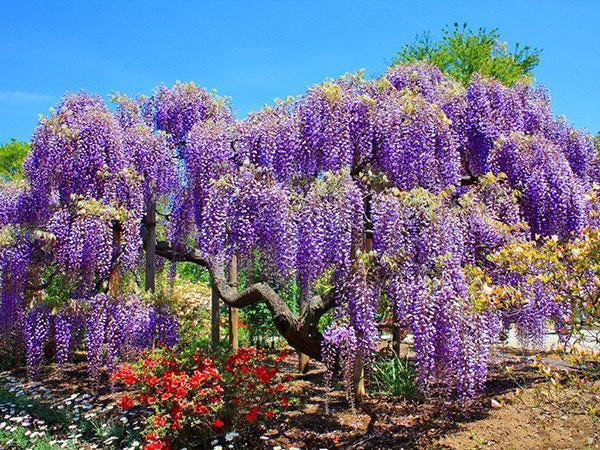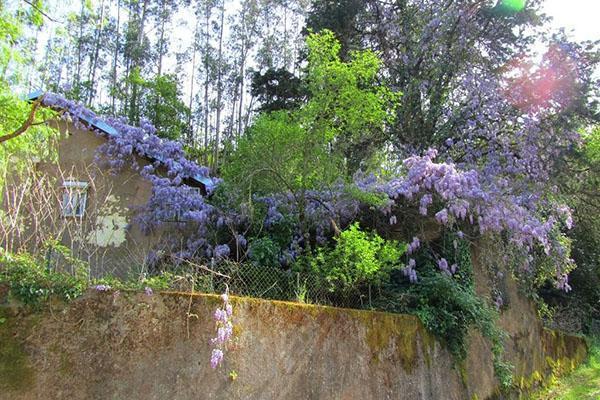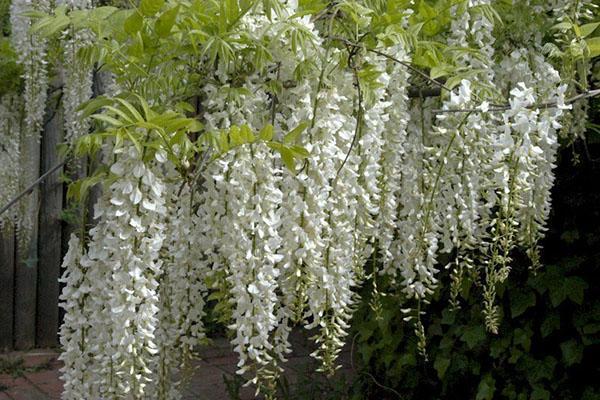Getting to know the main types of beautiful wisteria
 Wisteria, or wisteria, as it is also called, is a tree-like plant that belongs to the legume family. His homeland is the southern countries. It is on such lands that wisteria feels very good and pleases with abundant flowering. This type of plant is indispensable for landscape design. The uniqueness of the flower lies in its unusual racemose inflorescences. There are several varieties of a wonderful flower, which have their own characteristics. A photo of wisteria can be viewed below.
Wisteria, or wisteria, as it is also called, is a tree-like plant that belongs to the legume family. His homeland is the southern countries. It is on such lands that wisteria feels very good and pleases with abundant flowering. This type of plant is indispensable for landscape design. The uniqueness of the flower lies in its unusual racemose inflorescences. There are several varieties of a wonderful flower, which have their own characteristics. A photo of wisteria can be viewed below.
A variety of wisteria
Wisteria is a deciduous vine that grows up to 20 meters tall. A distinctive feature of this type of plant is the hanging branches. Leaves are odd-pinnate. The plates grow up to 40 cm long. The surface of young leaves is abundantly covered with small villi.
The buds are small, clustered in cluster-like inflorescences. Their length reaches 50 cm. When opened, the buds are violet, white, purple in color. Most often, liana is planted near fences, arbors.
Since the flower grows rapidly, a place should be prepared in advance for planting so as not to injure it in the future.
There are 9 types of wisteria in nature. Most of them prefer a tropical climate. On the territory of Russia, breeding varieties grow that well tolerate sudden changes in temperature.
Chinese Wisteria Blue Sapphire

Chinese wisteria Alba
 The variety is a perennial deciduous liana. The uniqueness of the species lies in the many flowing shoots. With proper care, they can be up to 25 meters long. The stems are massive. The diameter of the branches is 30-35 centimeters. Young shoots are soft and bend well, but over time they become woody. The presented variety is distinguished by white clusters, but there are hybrids that acquire a pink and lavender hue. Compared to other species, Alba has a long flowering period. She pleases with her beauty twice a year. The first bloom is observed in early spring, and the second - in late summer. This type of wisteria tolerates frost and cold winds well.
The variety is a perennial deciduous liana. The uniqueness of the species lies in the many flowing shoots. With proper care, they can be up to 25 meters long. The stems are massive. The diameter of the branches is 30-35 centimeters. Young shoots are soft and bend well, but over time they become woody. The presented variety is distinguished by white clusters, but there are hybrids that acquire a pink and lavender hue. Compared to other species, Alba has a long flowering period. She pleases with her beauty twice a year. The first bloom is observed in early spring, and the second - in late summer. This type of wisteria tolerates frost and cold winds well.
Wisteria abundantly flowering
One of the smaller varieties. If you take proper care of it and prune it in a timely manner, the vine will grow up to 10 meters high. It is a frost-resistant species that is able to withstand temperatures as low as -230C. Deciduous plates are large. Each consists of 11-19 ovoid parts. The leaves grow up to 40 centimeters long. This type of wisteria can be distinguished by the shape of the stems. Its shoots twist only clockwise. Their thickness at the base is 30 cm. Liana blooms, as a rule, from March to May, but with the right choice of place and care, the process can be repeated in summer. Racemes are formed at the ends of the shoots.They take on a lilac-blue hue and grow up to 60 centimeters long. The flowers bloom gradually. After flowering, fruits are formed, which remain on the branches until spring.
The main varieties of blooming wisteria:
- White - snow-white buds;

- Rosea - light pink flowers;

- Violaceo-plena - purple, double inflorescences;

- Macrobotrys is a large-leaved variety with elongated leaves.

Wisteria Macrostachia
 The homeland of this species is the lands of North America. Liana differs in dense, large inflorescences. The most popular varieties are Wisteria Macrostachia Blue Moon and Clara Mac. The first belongs to the group of hardy plants. This vine can be grown even in the northern regions. She is able to withstand sudden changes in temperature. The plant does not lose its appearance even at an air temperature of -400FROM.
The homeland of this species is the lands of North America. Liana differs in dense, large inflorescences. The most popular varieties are Wisteria Macrostachia Blue Moon and Clara Mac. The first belongs to the group of hardy plants. This vine can be grown even in the northern regions. She is able to withstand sudden changes in temperature. The plant does not lose its appearance even at an air temperature of -400FROM.
 Wisteria Blue moon is a deciduous, tree-like liana that reaches a height of 8 meters. Deciduous plates of complex shape. They consist of 7 or 9 pointed parts. The inflorescences are cone-shaped. Flowers are lilac-blue. This variety is often used for vertical gardening of gardens, arbors, terraces. Wisteria Clara Mac is a less hardy variety. The plant has snow-white brushes 35 cm long.
Wisteria Blue moon is a deciduous, tree-like liana that reaches a height of 8 meters. Deciduous plates of complex shape. They consist of 7 or 9 pointed parts. The inflorescences are cone-shaped. Flowers are lilac-blue. This variety is often used for vertical gardening of gardens, arbors, terraces. Wisteria Clara Mac is a less hardy variety. The plant has snow-white brushes 35 cm long.
Indoor wisteria
 Wisteria is a flower that can be grown not only in gardens, but also indoors. Liana grows up to three meters tall, so it needs frequent pruning. The tree is perfect for any room interior. It will look good both in the lobby and in the winter garden. In order for wisteria to please for a long time with its abundant flowering, it is necessary to provide it with proper care. In winter, the flowerpot with the plant should be kept in a well-lit room. The optimum air temperature is considered to be indicators from 150From to 200C. In order for the vine to look neat, it is necessary to prune young branches every spring. In the summer months, it is recommended to take the flower out to the balcony or terrace.
Wisteria is a flower that can be grown not only in gardens, but also indoors. Liana grows up to three meters tall, so it needs frequent pruning. The tree is perfect for any room interior. It will look good both in the lobby and in the winter garden. In order for wisteria to please for a long time with its abundant flowering, it is necessary to provide it with proper care. In winter, the flowerpot with the plant should be kept in a well-lit room. The optimum air temperature is considered to be indicators from 150From to 200C. In order for the vine to look neat, it is necessary to prune young branches every spring. In the summer months, it is recommended to take the flower out to the balcony or terrace.
It is necessary to start giving the desired shape to Chinese Wisteria at a young age, when the branches are still well bent.
Japanese wisteria is no less popular. She's not that decorative, but pretty pretty. Inflorescences are white, lush. The first flowering of this species can be observed at the 10th year of life. The plant is distinguished by large leaves and inflorescences. The height of the tree rarely reaches 8 meters.
 Shrub species - Wisteria frutescens reaches fifteen meters. The twigs are drooping. Flowers are small, collected in bunches. The buds are bluish-violet. With proper care, the inflorescences grow up to 15 cm long. The shrub species grows rather slowly, therefore it is less popular. This wisteria can be grown both in the open field and in tubs.
Shrub species - Wisteria frutescens reaches fifteen meters. The twigs are drooping. Flowers are small, collected in bunches. The buds are bluish-violet. With proper care, the inflorescences grow up to 15 cm long. The shrub species grows rather slowly, therefore it is less popular. This wisteria can be grown both in the open field and in tubs.
 The Wisteria tree is often used to create bonsai. Flexible and fast growing shoots allow you to create an unusual shape. The plant is very easy to care for. In order for a tree to bloom profusely, you do not need to have special skills.
The Wisteria tree is often used to create bonsai. Flexible and fast growing shoots allow you to create an unusual shape. The plant is very easy to care for. In order for a tree to bloom profusely, you do not need to have special skills.
Wisteria in landscape design, photo
The tree has not only unusual colors, but also wide foliage. Any building or garden can be transformed with this plant. Landscape designers consider Wisteria to be an essential part of any site. Liana looks great with any plants, especially with daffodils, tulips and hyacinths... Below are photos of wisteria in landscape design:




Hello, tell me how to stimulate an adult adenium to give seeds?
Adeniums bloom for 3-4 years of life, provided that their content is as close to natural as possible. To get plants to bloom, you need to provide them with bright lighting and proper feeding (without excess nitrogen).The dormant period is also important, during which excessive watering should be avoided and the flower should have a cool (16 degrees Celsius) wintering.
But the most important condition for obtaining seeds from home adenium is pollination - without it, nothing will work. Some growers take the plant outdoors in the summer to be pollinated by insects, but most prefer to do artificial pollination. Sometimes adenium self-pollinates, but this way the variety degenerates faster. Try "hummingbird" during the next flowering and pollinate your flower.